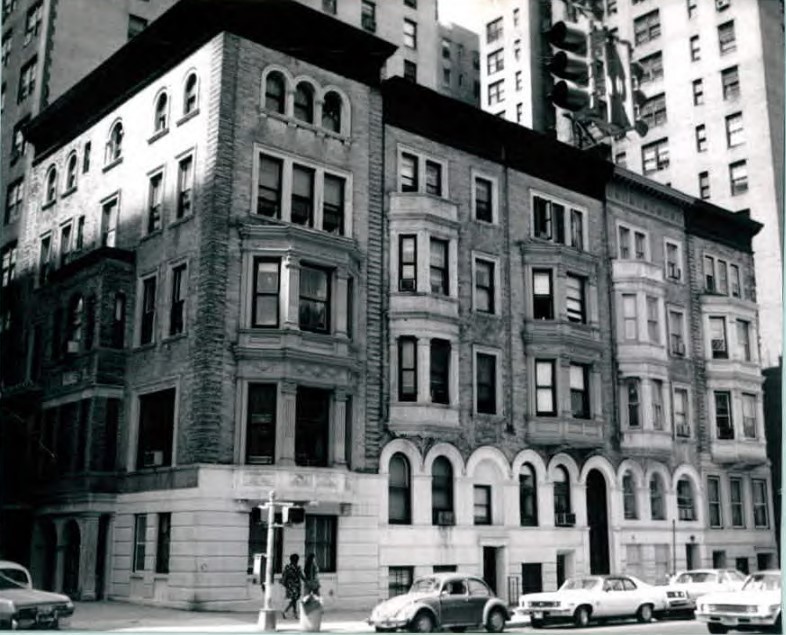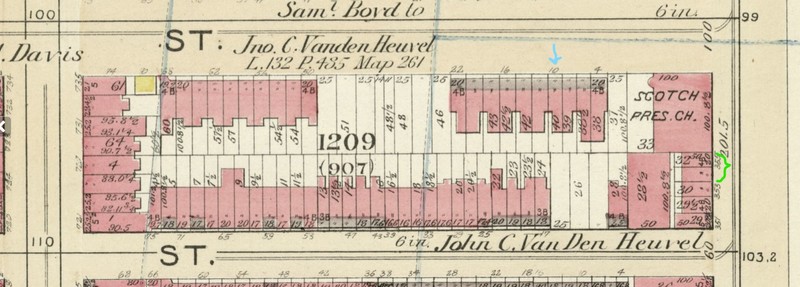Rowhouses at 354-355 Central Park West
Introduction
Text-to-speech Audio
These two surviving structures are the last of a line of five rowhouses that were constructed in 1892. The three rowhouses that formerly stood to the south of these two homes were demolished in 1989 in order to construct a high-rise building on the corner with W. 95th Street. All five rowhouses were built in 1892 for Edward Kilpatrick as multi-dwelling rental apartments. Much of Central Park West was lined with similarly-sized rowhouses up to the 1910s, a decade that saw the start of a trend of demolishing existing structures to build taller apartment buildings and commercial buildings. The rowhouses were designed by G. A. Schellenger and feature bow windows, Neo-Romanesque details, and pressed tin cornices.
Images
All five rowhouses at 351-355 Central Park W. as seen in 1975; two remaining (354-355) at right end (Howard)

Rowhouses at 354-355 Central Park West (green bracket) and residence of other "cave boy" (blue arrow) on 1894 map (Bromley p. 36)

Backstory and Context
Text-to-speech Audio
The five rowhouses are accented with Neo-Renaissance detailing and are composed of limestone, light colored brick, and terra cotta. The former rowhouse at the south end of the row of five also went by the address 1 W. 95th Street; this was the lone rowhouse that covered the whole 50-foot lot depth; the others had 8-foot backyards backing onto an alley. The 19-story condominium apartment building that replaced the southern three rowhouses was completed in 1992. The Scotch Presbyterian Church stood just to the north of the rowhouses and was a brick building that extended north to W. 96th Street.
The pair of five-story structures that remain have slightly different designs. The southern of the two (354 Central Park W.) features a a trio of arched windows on the second floor, with the window on the right, above the first-floor entrance, wider than the others. There are stacked, bowed windows above the narrow windows on the third and fourth floors. Decorative accents on the tan brick rowhouse include a floral motif below the cornice.
The northernmost rowhouse (#355) also has the main entrance recessed on the right-hand side, below a wider second-floor window than the two windows to the left. The windows are rectangular on this rowhouse, and the stacked, bowed windows are centered and take up the third and fourth-floor bays. Brick quoining emphasizes the corners of the main facade, made up of multiple colors of buff brick.
The rowhouse at #354 was occupied by the Cahen family into the 1920s; Caroline Cahen passed away there in 1921 at age 78. The Cahen household's children had a penchant for winning contests run by the newspaper; 14-year-old Harold A. won in 1905 and 12-year-old Edith won a watch in 1908. Number 354 is currently divided into five rental units; the entire building is only 20 feet wide and 42 feet deep. The building contains a total of 24 rooms with nine bedrooms and five baths. The 5,000-square-foot, walk-up building with a basement was listed for sale in 2021 for $8.5 million.
The rowhouse at #355 was sold in 1902 to L. M. Aldrich by William F. Carroll. The four-story plus a basement was described as a dwelling house on a lot 29 by 50 feet. Sylvester Gutelius, a teenaged resident of #355 and the son of newspaper broker William H. Gutelius, ran away from home in late April 1907 with another teenaged boy, John McWilliams Wylie. The boys sold their bicycles for $25 for train fare and headed out of town with their suitcases. A box of camping gear they'd hidden in the backyard was too heavy to carry so they left it behind. They first lived in a farmhouse but later moved to a cave. The other father, Rev. Dr. David G. Wylie of the Scotch Presbyterian Church next door, was tipped off by the local store where the boys shopped for provisions, and headed to Millville, Pennsylvania with his other son to retrieve them. The "cave boys" (as they were dubbed by the newspaper) had lined up a job for the following week at a local stone quarry and were reluctant to give up their adventure and return to school, but gave in and returned, tanned "a glowing brown." The church parsonage was nearby, at 10 W. 96th Street. Number 355 is currently not for sale and last sold in 2009 for almost $6.6 million.
Sources
Anonymous. "Real Estate." New-York Tribune (New York, NY) June 4th 1902. 11-11.
Anonymous. "Things to Think About." New-York Tribune (New York, NY) June 11th 1905. 5-5.
Anonymous. "Runaway Boys Found." New-York Tribune (New York, NY) May 3rd 1907. 4-4.
Anonymous. "Cave Boys Come Home." New-York Tribune (New York, NY) May 4th 1907. 9-9.
Anonymous. "Last Week's Prize Winners." New-York Tribune (New York, NY) May 24th 1908. 5-5.
Anonymous. "Cahen - Caroline." New York Herald (New York, NY) November 11th 1921. Deaths sec, 9-9.
Diamondstein-Spielvogel, Barbaralee. The Landmarks of New York: An Illustrated History of the City's Historic Buildings. Edition Fifth. Albany, NY. State University of New York Press, 2011.
Howard, Alexandra Cushing. Building-Structure Inventory Form for 351-355 Central Park West, N.Y., N.Y.. Albany, NY. Division for Historic Preservation, New York State Parks and Recreation, 1975.
StreetEasy. 354 Central Park West #1, Street Easy. September 1st 2021. Accessed September 23rd 2021. https://streeteasy.com/building/354-central-park-west-house/1.
StreetEasy. 355 Central Park West House. Street Easy. September 1st 2021. Accessed September 23rd 2021.https://streeteasy.com/building/355-central-park-west-house#tab_building_detail=2
New York State Cultural Resource Information System (NYS CRIS): https://cris.parks.ny.gov/Default.aspx
Library of Congress (LOC): https://www.loc.gov/item/2010587355/
